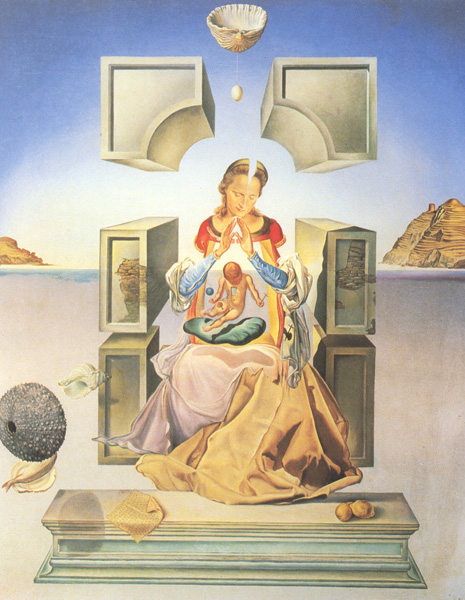|
Dali wanted to revolutionize the art of the twentieth century. All
of his initial efforts to improve techniques that were already mastered
did not gain him any significant fame. He tried to improve many different
styles of art, such as Impressionism, Pointillism, Futurism,
Cubism, and Neo-Cubism (Secrest 15). Nevertheless, he sought
to fulfill the needs of his mental and social life through a new form
of art. This new style of art was Surrealism that allowed Dali to express
all of his “erotic desires” and at the same time change the
way the world viewed art.
Dali sought a change in his life after the meeting with the Surrealists
in 1928 in Paris and he knew that this change was not going to occur
in Catalonia. However, the Surrealists saw in Dali the future of the
movement, because he was armed with an exceptionally rich imaginary
baggage. This baggage was a result of his erotic desires for women and
his undying interest in the concept of the unconsciousness devised by
Sigmund Freud. His precise style enhanced the nightmare effect
of his paintings. By 1929 he had become a leader of surrealism.
Dali’s first Surrealist period was in the year of 1929 when he
first joined the movement in Paris. One of his most prominent works
during this period is The Great Masturbator, which was
influenced by his strong attraction to the wife of Paul
Eluard, Gala (Secrest 128). The main subject in
this work is a large female figure with a fractured head, yet very calm
and taken into deep emotions. The presence of the cracks on the face
could signify a form of physical exhaustion. Nevertheless, the picture
can be analyzed from different aspects since Dali was able to incorporate
many odd objects to it. An example of this is what appears to be a grasshopper
on the woman’s belly. This work somewhat depicts Dali’s emotions
toward Gala. The appearance of Gala was a revelation for him. He saw
in her the imaginary female figure that he has been long waiting for.
Gala for him was an object of worship, because she represented his childhood
reveries.
As his style matured, Dali’s works became more and more affected
by the concept of psychoanalysis devised by Freud. Dali’s works
were increasingly shaped into dreamlike illustrations. This was clearly
seen in his most famous work the The Persistence of Memory, in
which he depicted several clocks as melted in a desert setting with
the ocean appearing below the horizon. Dreams consisted of a large segment
of his life, because he would take siestas, or midday rests, in which
he encounters more and more dreams (Etherington-Smith 9). He
considered the siesta as a state that is achieved at the moment that
one forgets about one’s body or in psychoanalysis the state of
the unconscious. Yet, his dreamlike style was combined with his sexual
desires to give a variety of works with different themes.
Among them is The Spectre of Sex Appeal, in which he depicts
himself as a child watching a brutalized body of a woman, who is barely
able to support herself with the aid of the sticks (Secrest 130).
Her head seems indistinguishable and seems as if it blends with the
giant rocky cliff in the background. He depicts this state of exhaustion
of the woman by the use of crutches to support her back and her arm.
This style persisted in numerous of Dali’s future works and did
not mature any further; rather, he tried to keep it consistent to address
different themes with the same effectiveness. Nevertheless, Dali adopted
the influence of politics and religion into his surrealist style.
In 1934, Dali was accused of showing an interest in the fascist movement
led by Hitler and as a result he was kicked out of the Surrealist group
in Paris. This did not affect Dali’s art or life because by that
time he was well known worldwide for his special style. The main advancement
in Dali’s style was the production of religious works. The most
famous and also the first of all of his religious works was The Madonna
of Port Lligat, in which he arranged the picture around a piece
of bread that is visible through a hole in Jesus’ body (Etherington-Smith
328). Here the influence of Gala was also seen, because he incorporated
her into the picture as the Virgin and as angels.
|
|

Study, The Madonna of Port Lligat
The style of Salvador Dali was the most famous and most creative of
the twentieth century because he developed and nourished a style that
was insignificant before his time. The dominant themes in his career
revolved around his childhood sexual desires and on the study of the
unconscious mind. Gala’s presence in his life greatly relieved
of many mental complication, which allowed him to incorporate other
themes into his works later in his career. The Great Masturbator,
The Persistence of Memory, The Specter of Sex Appeal, and The
Madonna of Port Lligat are the works that can summarize the themes
that were incorporated into most of Dali’s works.
Works Cited
Secrest, Meryle. Salvador Dalí. New York: E.
P. Dutton, 1986.
Etherington-Smith, Meredith. The Persistence of Memory:
A Biography of Dalí. New York: Random House, 1992.
|
